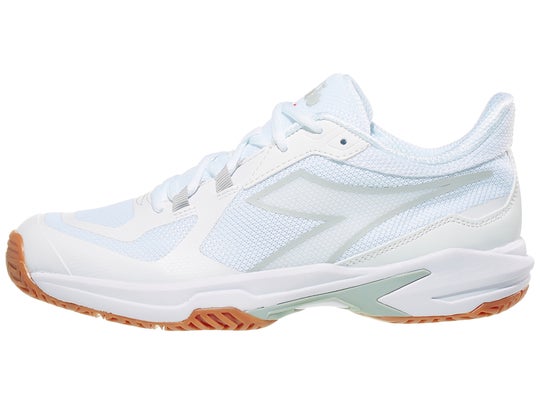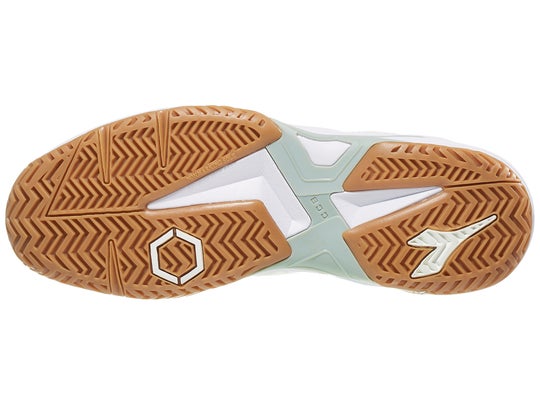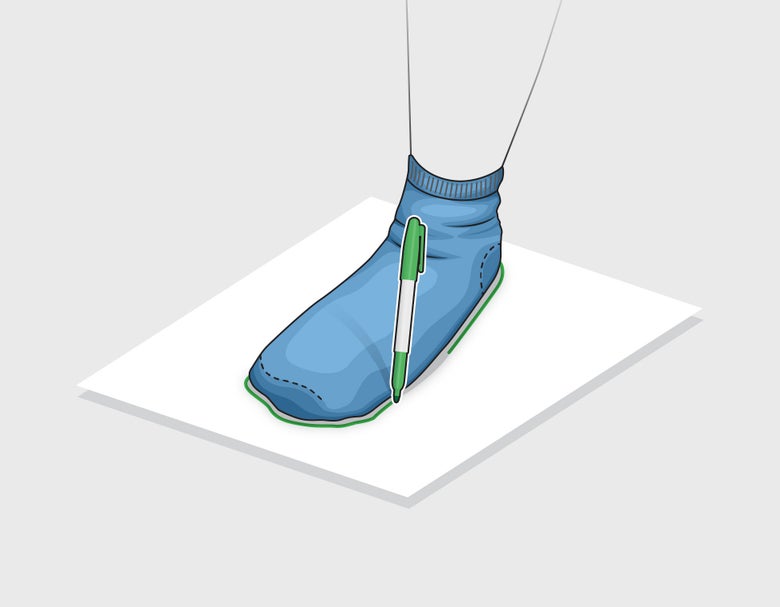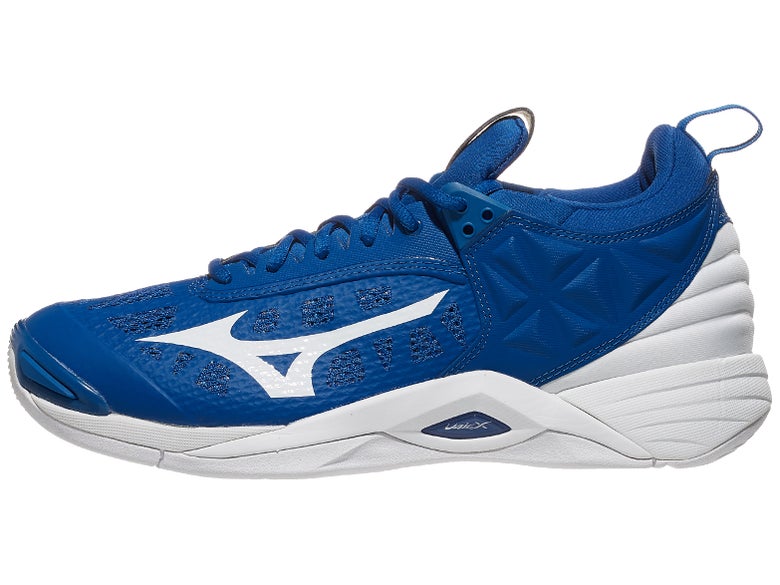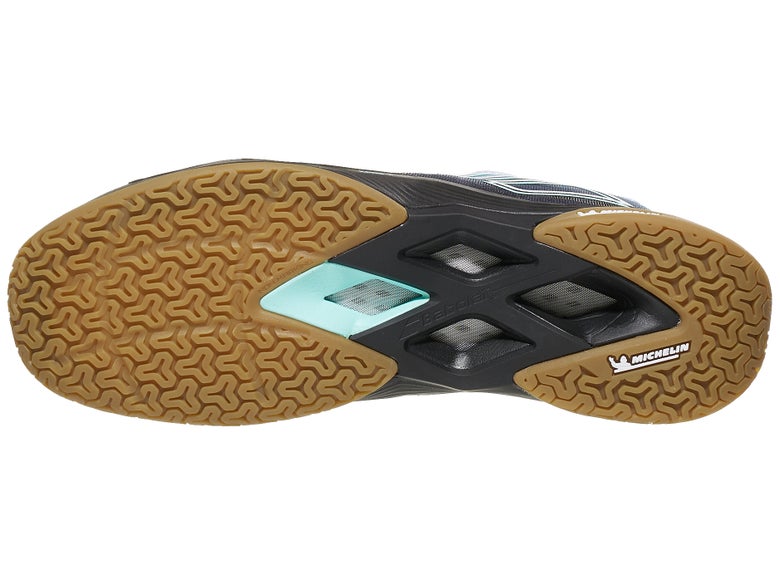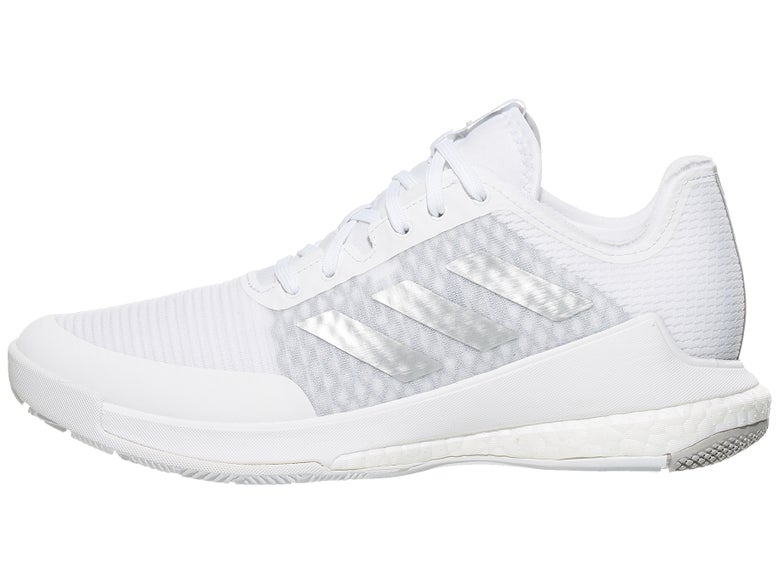Racquetball Shoe Buying Guide
If you're serious about playing racquetball, you need the right equipment, including a good pair of racquetball shoes. Over the years, we’ve had many customers ask us, “Can I wear my running shoes while playing racquetball?” While you might be able to wear running shoes to play racquetball, we’ve seen a lot of injuries and game play mistakes that could have been avoided with proper racquetball footwear.
The typical follow-up question we receive is, “What makes racquetball shoes different than other athletic shoes?” Racquetball shoes are designed for the unique demands of the sport, providing the support, stability, and grip you need to avoid injury and perform your best on the court. Additionally, the majority of racquetball shoes are designed to be non-marking since most racquetball facilities require non-marking shoes in order to protect their court.
We’ll dig more into the differences between racquetball shoes and other athletic shoes, but with so many racquetball shoe options available, we understand that it can be difficult to know what qualities and features to look for in a new pair. Luckily, we’ve made this racquetball shoe buying guide to help explain what to consider when selecting the best racquetball shoes for your needs!
What Makes Racquetball Shoes Different from Other Athletic Shoes?
Before we get into individual racquetball shoe qualities and features, it’s important to understand why other athletic shoes don’t work well on a racquetball court.
The Diadora Trofeo 2 Indoor shoe shown above is an example of a gum rubber outsole that is ideal for an indoor court.
Running shoes are designed for forward motion and straightforward foot movement. Since racquetball requires multi-directional lateral movements with your feet, it can be easy to trip over the cushioning found in running shoes and rolling or twisted ankles are common. You may think then that tennis shoes would work well for racquetball courts but unfortunately, the difference in court materials doesn’t make them ideal. Tennis shoes are made for tennis courts, which have much more grip and friction than racquetball courts, making slipping common.
Basketball and volleyball shoes are the most similar to racquetball shoes since all 3 sports require lateral movements and are played indoors, but we find that the majority of players will feel the most comfortable, safe, stylish, and competitive in a new pair of racquetball shoes.
Lastly, it should be noted that most racquetball facilities will not allow you to play in shoes that are made for other sports. Racquetball courts are scuffed and marked easily, making gum soled and or non-marking shoes a requirement to play on most courts. Don’t risk having to pay for a court to be cleaned or worse, being banned from using a court because you want to try using your running shoes or other improper footwear!
Racquetball Shoe Product Considerations
Now that we understand the differences between racquetball shoes and other athletic shoes, let’s dig into what shoe qualities you should look for when finding your perfect pair.
Shoe Fit & How to Get Your Racquetball Shoe Size
The most important factor to consider when choosing racquetball shoes is the shoe fit. You need shoes that fit well, as shoes that are too tight or too loose can cause discomfort, blisters, and even injury. Look for shoes that fit snugly but not too tightly, with enough room in the toe box to wiggle your toes. If you have wider feet, look for shoes that come in wider sizes or consider a brand that tends to run wider.
Most Racquetball shoes are made true to size and are manufactured by large sporting good brands that you are likely familiar with such as Nike, adidas, ASICS, & more. If you have purchased shoes from one of these brands in the past and liked or disliked your fit with a particular size, keep this in mind as you shop for racquetball shoes.
Haven’t bought a new pair of shoes in a while or don’t know what size racquetball shoes will fit best? Follow our step-by-step instructions for measuring your feet at home so that you can get perfect fitting racquetball shoes!
How to Measure Your Foot
Step 1: Find a hard, flat surface and place a piece of paper on the floor.
Step 2: Wear socks that are similar to what you plan to wear when playing tennis. Stand with one foot on the paper.
Step 3: Keeping your body weight over your foot, trace a thin line around the outside of your entire foot. When drawing the line, hold the pen perpendicular to the ground.
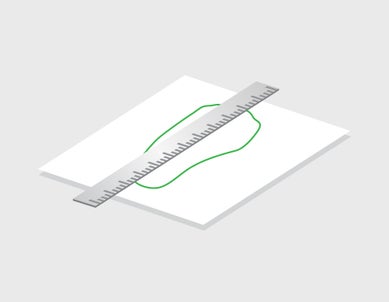
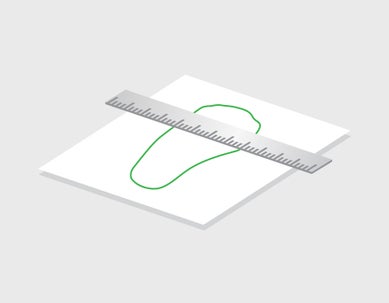
Step 4: Measure vertically down the length of your foot tracing. This is your foot length.
Step 5: Measure horizontally across the widest part of your foot tracing. This is your foot width.
Find your shoe size & width
Make sure you are looking in the proper column, either men's or women's, when determining your size. The standard width for women is B. The standard width for men is D. *Note: This chart is here to give you a general idea on sizing and widths. Tennis Warehouse is not responsible for mismeasurements or ordering the wrong size. We recommend that you order the size that you normally wear in other shoes.
Men's Shoe Sizing Chart
| Length of foot | US Size | Width | |||
| Inches | Centimeters | C | D (standard) | E | |
| 9 1/3 | 23.7 | 6 | 3.3" | 3.5" | 3.7" |
| 9 1/2 | 24.1 | 6.5 | 3.3" | 3.6" | 3.8" |
| 9 2/3 | 24.6 | 7 | 3.4" | 3.6" | 3.8" |
| 9 4/5 | 25 | 7.5 | 3.4" | 3.7" | 3.9" |
| 10 | 25.4 | 8 | 3.5" | 3.8" | 3.9" |
| 10 1/6 | 25.8 | 8.5 | 3.6" | 3.8" | 4.0" |
| 10 1/3 | 26.2 | 9 | 3.6" | 3.9" | 4.1" |
| 10 1/2 | 26.7 | 9.5 | 3.7" | 3.9" | 4.1" |
| 10 2/3 | 27.1 | 10 | 3.8" | 4.0" | 4.2" |
| 10 5/6 | 27.5 | 10.5 | 3.8" | 4.1" | 4.3" |
| 11 | 27.9 | 11 | 3.9" | 4.1" | 4.3" |
| 11 1/6 | 28.4 | 11.5 | 3.9" | 4.2" | 4.4" |
| 11 1/3 | 28.8 | 12 | 4.0" | 4.3" | 4.4" |
| 11 1/2 | 29.2 | 12.5 | 4.1" | 4.3" | 4.5" |
| 11 2/3 | 29.6 | 13 | 4.1" | 4.4" | 4.6" |
Women's Shoe Sizing Chart
| Length of foot | US Size | Width | |||
| Inches | Centimeters | A | B (standard) | C | |
| 8 1/2 | 21.6 | 5 | 2.6" | 2.8" | 3.0" |
| 8 2/3 | 22.0 | 5.5 | 2.7" | 2.9" | 3.1" |
| 8 5/6 | 22.4 | 6 | 2.8" | 2.9" | 3.1" |
| 9 | 22.9 | 6.5 | 2.8" | 3.0" | 3.2" |
| 9 1/16 | 23.3 | 7 | 2.9" | 3.1" | 3.3" |
| 9 1/3 | 23.7 | 7.5 | 2.9" | 3.1" | 3.3" |
| 9 1/2 | 24.1 | 8 | 3.0" | 3.2" | 3.4" |
| 9 2/3 | 24.6 | 8.5 | 3.1" | 3.3" | 3.4" |
| 9 5/16 | 25 | 9 | 3.1" | 3.3" | 3.5" |
| 10 | 25.4 | 9.5 | 3.2" | 3.4" | 3.6" |
| 10 1/6 | 25.8 | 10 | 3.3" | 3.4" | 3.6" |
| 10 1/3 | 26.2 | 10.5 | 3.3" | 3.5" | 3.7" |
Now that you understand and know your width and length, look out for the fit details in our product descriptions to determine if the tennis shoes you are interested in are a good fit for your feet. We try on all the shoes we sell to provide you guidance on how they fit for length, width and arch support.
Racquetball Shoe Cushioning & Support
Athletic shoes generally have much more cushioning than non-athletic shoes to help absorb the extra impact that is transferred to your feet and body during sports. Due to the running, jumping, and pivoting required in game, racquetball is considered a high-impact sport that places a lot of stress on your feet, joints, and bones. Because of this, racquetball shoes are generally designed to have a high level of cushioning and support.
Shoes with extra padding around the ankle and heel can provide added support and comfort. Shoes with less cushioning will generally have less support but will likely be lighter in weight and allow for more flex with your foot. If you are a bigger player physically that focuses on power shots, then a racquetball shoe with max cushioning and minimal flex will likely serve you well, whereas if you are a smaller player physically that focuses on agility and quick shots, then a racquetball shoe with less cushioning and more flex may serve you better.
Understanding your foot and physical needs along with your playing style will help you better select your desired level of cushioning. Different racquetball shoe brands and models will have different levels of support or cushioning. Overall, be sure to look for shoes that provide adequate cushioning and support to absorb impact and reduce the risk of injury.
Lastly, the insole of your shoe can also affect your foot support. Insoles are not typically one of the main considerations for selecting a new pair of shoes but be sure they fit perfectly in the shoe and make your feet comfortable. If you find that the insole of your shoes is not as supportive as you’d like or if the insoles are not as comfortable over time, it could be time to replace your shoe insoles.
Racquetball Shoe Outsole Material & Grip Pattern
The outsole of your racquetball shoes is crucial for grip and stability on the court. The first thing to consider with outsoles is material.
A lot of athletic shoes are made with standard rubber outsoles which work well on outdoor surfaces but are not the most ideal material for indoor court surfaces. Most racquetball shoe outsoles are made with gum rubber or a hybrid rubber since these materials provide more traction than standard rubber, can offer ergonomic foot design options, and can be made to be non-marking to avoid scuffing the court floor.
Besides the outsole material, it is also important to consider the outsole pattern or grip design. The outsole pattern of the shoe is the design that you will find on the bottom of the shoe and will greatly affect shoe traction and grip. Athletic shoe outsole patterns will vary depending on the needs of the sport, so racquetball shoes should be designed to provide you with enough grip to change direction easily, speed up or slow down quickly, and overall prevent you from slipping while playing. The most common outsole patterns that you will see with racquetball shoes include zig zag lines, herringbone, and custom brand patterns.
Breathability & Shoe Upper Design
Racquetball is a fast-paced sport that can be physically demanding, so your feet are likely to get hot and sweat. The material above the shoe sole, also known as shoe upper, will be the biggest factor in allowing your feet to breathe.
Look for shoes with breathable upper material and or a design that allows air to circulate and helps keep your feet cool. By increasing breathability, you will help eliminate sweat, which can help decrease the likelihood of your feet slipping out of your shoes. Additionally, nobody likes sweaty, smelly feet, so this is an added bonus! Look for lightweight or mesh material and perforated uppers as these are our favorite shoe styles for breathability.
Durability - Shoe Upper & Outsole Materials
Racquetball shoes take a beating due to the stretching of uppers material caused by your feet and the amount of friction that comes between your outsoles and the court. Because of this, you will want to get racquetball shoes that are built to last.
Look for shoe uppers made with durable synthetic materials, such as mesh or fabric made from nylon or suede and reinforced stitching. Most athletic shoes were traditionally made with leather due to it’s ability to stretch and durability, but leather can get very hot and is heavy, so synthetic mesh or even synthetic imitation leather materials are generally more ideal for playing racquetball.
As mentioned above, most racquetball shoes are made with gum rubber or hybrid rubber specifically designed for racquetball courts, so these materials are your best shot for outsole longevity. Lastly, shoes with reinforced toe caps can also help protect the shoe from wear and tear.
Style and Design
While style and design shouldn't be your top priority when choosing racquetball shoes, it's still important since you should be excited to show off your shoes! Look for shoes that match your personal style and preferences, as you'll be more likely to wear shoes that you like.
Racquetball shoes come in a wide variety of styles to accommodate flashy, colorful shoe style preferences or more neutral, single-color styles for those who prefer a traditional, less flashy shoe appearance.
Racquetball Shoe Pricing
Racquetball shoes typically range in price from around $50 to $150 or more. While it's important to invest in good quality shoes that will provide the support and durability you need, you don't necessarily need to spend a fortune. Look for shoes that fit your budget while still meeting your needs for all of the key factors that we have covered above.
Brand Selection
Finally, consider the reputation and or your familiarity with brands when choosing racquetball shoes. Look for brands that you are a fan of or brands that are known for producing high-quality, durable shoes that are specifically designed for racquetball.
Final Thoughts
In summary, when choosing the best racquetball shoes, you need to consider fit, cushioning and support, outsole material, breathability, durability, style, price, and brand. By weighing these factors, you should be able to find the perfect pair of shoes to help you play safe and perform your best on the court!
At Racquetball Warehouse, we have tested hundreds of racquetball shoes over the years and carry quality brands such as, ASICS, adidas, Mizuno, Nike, Babolat, Head, and Diadora. We encourage you to explore our wide selection of racquetball shoes and see which pair could be best for you!
Got a new pair and ready to play? Continue reading to learn more about breaking in your new racquetball shoes and get answers to the most frequently asked questions we receive from customers.
How to Break in New Racquetball Shoes
Once you've chosen the best racquetball shoes for your needs, it's important to break them in properly to avoid discomfort and injury on the court. Here are some tips for breaking in new racquetball shoes:
- Wear your shoes around the house for short periods of time to help them mold to the shape of your feet. Gradually increase the amount of time you wear your shoes each day, wearing them for longer periods of time as they become more comfortable.
- Use a shoe stretcher to gently stretch the shoes if they feel too tight in certain areas.
- Wear your shoes for short practice sessions before wearing them for longer games to get used to how they feel on the court.
- Replace the insoles with ones that offer better cushioning and support if necessary.
Remember that it's important to break in your shoes gradually to avoid causing blisters or other foot problems. With proper care, your racquetball shoes can last for many games and tournaments to come!
FAQs
How often should I replace my racquetball shoes?
It's recommended to replace your racquetball shoes every six months to a year, depending on how often you play and how much wear and tear your shoes have endured. If you notice excessive signs of wear, if you are slipping more, or the shoes are no longer as comfortable as they used to be, then these are a few signs that it could be time for a new pair.
Can I wear my racquetball shoes for other sports?
While you can technically wear your racquetball shoes for other indoor sports, such as volleyball or basketball, it's not recommended. Each sport has its own specific shoe requirements, and wearing shoes designed for one sport for another can lead to discomfort, injury, and or poor performance.
Can I wear my racquetball shoes outside?
It is not recommended to wear your racquetball shoes outside before or after a game. Wearing your racquetball shoes when not actually playing a game will cause extra wear on your shoes which will shorten the life of your shoes. Additionally, it is not considered proper etiquette to wear your racquetball shoes outside as walking outside will cause your shoes to collect small pebbles or rocks in the groves of the shoe outsoles or grip which can scratch the court surface and potentially cause damage.
Can I wash my racquetball shoes?
Yes, you can wash your racquetball shoes to keep them clean and fresh. However, each brand of shoe is different, so be sure to follow the manufacturer's instructions for washing and drying to avoid damaging the shoes. Additionally, it is ideal to clean the bottom of your racquetball shoes before playing a game as dust can collect on your outsole and cause you to slip on the court.
